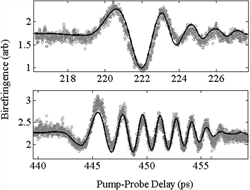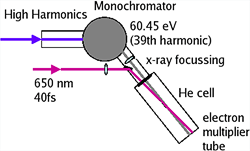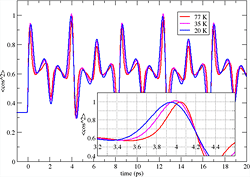|
PULSE Research
Atomic and Molecular Dynamics
Strongly Driven MoleculesWe are currently investigating various coherent processes in both atoms and molecules that are of value as either LCLS experiments or ultrafast x-ray diagnostics. One of our immediate goals is to obtain and study ro-vibrational control in small molecules in preparation for one of the first experiments in the AMO hutch of the LCLS. This LCLS experiment will focus on the laser induced alignment of molecular gases at densities conducive to x-ray absorption and scattering. To enhance this effort, we are currently in collaboration with LBNL and CEA Saclay to investigate angle resolved soft x-ray absorption and photo-electron spectroscopy. In the VUV regime, we are pursuing selective nonlinear absorbers as a possible means for LCLS beam conditioning. We are currently collaborating with the E2a project to use the HHG source as a probe of ultrafast resonant EIT. Also, in collaboration with project E2a, we are pursuing the natural molecular alignment produced in a poled polymer environment. We have performed preliminary x-ray scattering experiments and plan to use the scheme for studying chemical dynamics via time-resolved x-ray scattering at the LCLS.
Molecular Alignment 
Figure 1 Transient birefringence I2 following impulsive excitation with 800 nm, 40 fs pulses. Data are represented by gray circles and the semi-classical simulation is represented by the solid line.
We investigated impulsive laser alignment of molecular iodine at a density of ~1018 molecules/cm3 and a temperature of 120 C using a 1.5 mJ 40 fs 800 nm laser system [1]. In this experiment, we split the 1.5mJ beam into two arms. One arm is sent through a 250mm BBO crystal and produces ~20uJ of 400nm light. A polarizer ensures that this beam is horizontally polarized. The other arm serves as the laser alignment pulse. The alignment arm is polarization rotated to 45 degrees to the horizontal. This induces a transient birefringence in the gas cell. We observe this transient birefringence by measuring the amount of 400 nm light exiting the cell with vertical polarization. In Figure 1 we show the half- and full-revivals for iodine. The oscillatory signal is due to the strong effect of centrifugal distortion that exists for such a thermally hot ensemble of rotors. We have also begun a program to produce and detect impulsive molecular alignment along the direction of laser propagation. We have constructed an interferometric technique that is capable of detecting molecular alignment in a gas cell that does not produce a birefringence signal. This technique is run in parallel to the previously developed birefringence technique of Ref. [1] and allows us to measure and distinguish molecular alignment along any of the lab-fixed directions with only one, co-propagating, probe beam. This experiment is nearing completion. Upon final development of this technique, it will be used to produce laser aligned molecules at the LCLS where the alignment axis can be switched in real time from X to Y to Z for scattering experiments. We have recently purchased and installed a 3.5 mJ 35fs laser amplifier in the E2b lab in building 130 at SLAC. in this lab we are currently constructing a pulse stacking scheme that will be used for improved molecular alignment by a train of off resonant pulses. We are working to develop a 16 pulse analog of Ref [2] for use in a proposed LCLS experiment that aims to measure the angular distribution for photo-electrons by measuring many PE events per shot for lab-fixed molecules (see below).
XFEL Cleaning with EIT – joint with E2a. 
Figure 2 Use of the E2a HHG beam, monochromatized, for EIT in He.
We are currently pursuing electromagnetically induced transparency (EIT) in atomic He. We will conduct a proof of principle experiment using an existing high harmonic light source of sub-task E2a to evaluate the scalability to high intensity and hard x-ray sources such the LCLS. A new multi-pass amplifier is currently under construction in the E2a lab in Varian Physics. Upon completion of the multi-pass we will construct a high power visible NOPA to pump the EIT system on resonance. We will then investigate the effects of driving the transparency with strong resonant fields, with strong fields detuned from resonance, and with driving fields that have a shorter duration than the probe pulse. This last test is in the spirit of cleaning the LCLS pulses that span many tens of femtoseconds with a ~10fs EIT field gas in a cell.
Angle Resolved photo-electron Spectroscopy of Aligned Molecules We are working in collaboration with the group of Hamed Merdji from Saclay and Ali Belkacem from (LBNL) to perform angle resolved photo-electron spectroscopy to image the electron orbitals of simple molecules. This experiment will serve as a preliminary experiment for the angle resolved photo-electron spectroscopy experiment we are currently proposing for the initial phase of the LCLS.
An LCLS Proposal The goal of this proposal is to develop laser alignment techniques for molecular gas-phase experiments at the LCLS. The ability to spatially align target molecules will allow the measurement of photoelectron angular distributions. The advantage of laser alignment lies in the suppression of rotational averaging in order to provide lab frame sensitivity to molecular electronic structure. 
Figure 4 Above, we show a simple quantum calculation which qualitatively shows that even for nitrogen molecules as hot as 77K, there is a window of up to 400fs where the LCLS x-rays could probe laser aligned molecules.
LCLS is the first x-ray source that will allow us to exploit impulsive alignment for gas-phase x-ray applications. Transient alignment is prohibitively short for x-ray pulses available at third-generation synchrotron sources. In order to take x-ray snapshots of transiently aligned molecules, a pulse duration of 1 ps or shorter is required. Currently, the only synchrotron-based sources that provide such short pulses exploit laser slicing. However, gas-phase experiments using slicing sources are generally photon-starved and the contrast ratio of photons sliced to background is not ideal for orbital imaging techniques. At LCLS, we will have ~1013 photons per pulse at a repetition rate of 120 Hz, making it feasible to measure photoelectron angular distributions for a molecular ensemble that is transiently aligned with the lab frame.
Wave-packet interferometry An amplitude shaped visible spectrum NOPA is currently under construction in the E2b lab in building 130 at SLAC. This NOPA will be used to perform molecular wave-packet interferometry (WPI) in systems where de-coherence or dissociation prohibit the more traditional WPI technique of Ref. [3] by using pulses separated in frequency rather than time. It has been shown that WPI can be used to completely reconstruct both the amplitude and the phase of a molecular vibrational wave-packet. This new scheme would allow the reconstruction of dissociating wave-packets or those with fast decoherence. Although the initial experiment will use white light absorption as a probe to prove the principle, the ultimate goal is to use the hard x-ray end station of the LCLS as a probe. References:

|